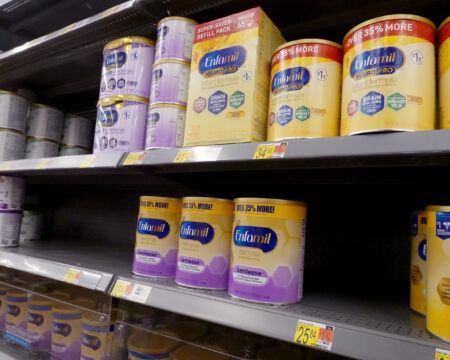AAP warns parents against using DIY infant formula
Here’s what a pediatrician recommends doing instead.

Rido/Shutterstock
Social media is rife with recipes on how to DIY infant formula amidst the ongoing infant formula shortage. But the American Academy of Pediatrics (AAP) strongly warns against using homemade formula or other formula substitutes like raw goat’s milk as a stopgap when baby formula is in short supply.
It’s an incredibly frustrating time for parents, who may feel like they’re left to their own devices as they struggle to find formula for their children. And even though we’re already months into the shortage, it seems that things might get worse before they get better. Recently, two infants were hospitalized due to the fact that they weren’t able to get the life-sustaining formula they need.
The FDA came to an agreement this week with Abbott Nutrition to bring their manufacturing facility back online beginning in the next two weeks, but we could still be months away from seeing formula cans back on shelves at typical stock levels. That means many parents and caregivers are left scrambling to find the right formula—and enough of it—to feed their babies.
But the risks of rationing formula, watering it down or forgoing packaged formula altogether for a homemade version can be dangerous.
“When people are desperate, when all they hear is ‘don’t, don’t, don’t,’ it can get very frustrating, because they understand that, but they don’t know what else to do,” says Florida-based pediatrician Mona Amin, DO. But there are serious risks and dangers to going the DIY route.
Here, Dr. Amin outlines those risks and shares more resources on what to do instead.
Risks of using DIY or homemade formula
DIY formula can be dangerous for infants for two primary reasons: It’s not sterile and it’s not nutritionally complete.
Formula is made in a sterile facility, says Dr. Amin. “There are checks and balances to make sure that it’s prepared in the correct way. And most people don’t have a sterile kitchen.” For babies under 3 months, who are at higher risk for infection, offering them formula that was not produced in a sterile facility can be especially dangerous, due to the risk of contamination.
Second, the formula sold in stores is approved by the Food and Drug Administration to have precise minimum and maximum levels of nutrients in the final product that can be difficult to emulate at home.
Related: The White House underscores the seriousness of the formula shortage: “A critically important issue”
“They have been created with nutritionists and scientists that examine the composition of everything together to make sure that the nutrients are what a child needs; the level of iron, lactose, the amount of protein—everything is measured for a reason to mimic breast milk as much as possible,” Dr. Amin notes.
Feeding babies homemade formula even for a few days or weeks can have lasting effects and put them at risk of getting sick, notes the AAP.
Same goes for feeding infants raw goat’s milk–it’s low in folate, notes Dr. Amin, which can cause a specific type of iron deficiency anemia.
Risks of rationing or diluting formula
When babies get all their nutrition from one source, as is the case with formula, that formula must be able to offer everything they need. If you’re forced to ration or dilute that formula to make it last longer, you’re inadvertently putting infants at risk of developing a nutrient deficiency that could affect their short-term and long-term growth. Watering down formula “provides an unbalanced diet and can cause serious growth problems,” says AAP.
Related: Formula-feeding moms don’t need breastmilk advice right now
Too much water in a baby’s formula can come with a serious risk of water toxicity, which can result in an electrolyte imbalance over the long-term and lead to seizures in severe cases. “If you are over-diluting your formula, that’s going to mean more water than your baby’s kidneys may be able to filter out. We want to make sure we don’t do that, because more water in the body can lead to sodium abnormalities,” says Dr. Amin.
What to do instead in the midst of the infant formula shortage
“At this point, it’s just a lot of legwork,” says Dr. Amin. “Don’t get me wrong, I don’t like it. It’s so stressful. But it may take a bit of work.” She recommends really leaning on your community, reaching out to friends, family and neighbors to track down the formula your baby needs.
Here are other tips to try:
Search for baby formula at smaller stores
Look for formula at convenience stores, small family-owned businesses and natural foods stores like Whole Foods Market, places you may not normally go to in search of formula. “You’ll want to make a rotational checklist to check inventory,” says Dr. Amin.
Be careful not to over-purchase
Secure a one- to two-week supply of formula for your family, but don’t buy out all the cans you see on the shelves in order to leave some for other families, notes Dr. Amin.
Seek out store-brand formula
Store-brand formula may be more readily available than brand-name formulas at this time.
“A family should have confidence that it is safe to move babies between infant formula products if they need to,” said Christen Linke, Deputy Assistant to the President for Health and Veterans Affairs at the White House, in an interview with Motherly. “Talk to your pediatrician if you have any questions, but folks should have absolute confidence in the safety of US products across the board, and in switching between products as they need to.”
Perrigo (the maker of all store-brand infant formulas in the U.S.) outlines which store-brand formula alternatives you might consider trying if you can’t find your preferred brand due to the current shortage.

Look into donated breast milk
You may also want to speak to your pediatrician about accessing donated breast milk, which is available via prescription and often saved for NICU babies, but it’s worth applying for if you’re in dire need.
Offer cow’s milk if your baby is older than 9 months
“I’m telling families to start transitioning to cow’s milk if their baby is over 9 months, or a plant-based alternative [soy milk or pea milk are preferred], so we can keep the formula for the younger babies who need it,” says Dr. Amin.
Consider incorporating some whole cow’s milk into your baby’s diet in addition to any formula you have on hand, or talk with your child’s pediatrician about whether it’s safe for your baby to start transitioning to more cow’s milk as a larger part of their diet, and whether an additional iron supplement is recommended. (Because cow’s milk has low levels of iron, drinking only cow’s milk can put babies at risk of an iron deficiency.)
Talk to your doctor about cow’s milk If your baby is younger than 9 months
Under 9 months of age, babies’ primary food source should still be breastmilk or formula, but due to the formula shortage, the AAP now recommends that if your child is at least 6 months old, you can offer whole cow’s milk for a short period of time as a holdover if you can’t find formula, and then switch back to formula as soon as possible. Just speak with your doctor first to rule out any potential complications. “Make sure the cow’s milk you offer is pasteurized, not raw,” adds Dr. Amin.
“The goal here is feeding our babies as safely as possible. We’re just trying to find the best options in this dire situation.”
Featured expert
Mona Amin, DO, is a board-certified pediatrician based in Florida. Find her @pedsdoctalk and pedsdoctalk.com.


